Organisational Design, HR, and Workforce Strategies: A Report
VerifiedAdded on 2023/01/03
|17
|4554
|33
Report
AI Summary
This report examines the importance of organisational design in relation to organisational structure and strategy, using Syngenta as a case study. It explores different organisational structures like hierarchical, flat, and matrix structures, analysing their impact on fulfilling organisational goals. The report delves into human capital theory and its application to employee development. Furthermore, it discusses various approaches and techniques for attracting, maintaining, developing, and rewarding human resources, including motivation theories and leadership styles such as transformational and participative management. The report concludes with an analysis of how organisational design responds and adapts to change management, providing a comprehensive overview of HR's value and contribution to organisational success.
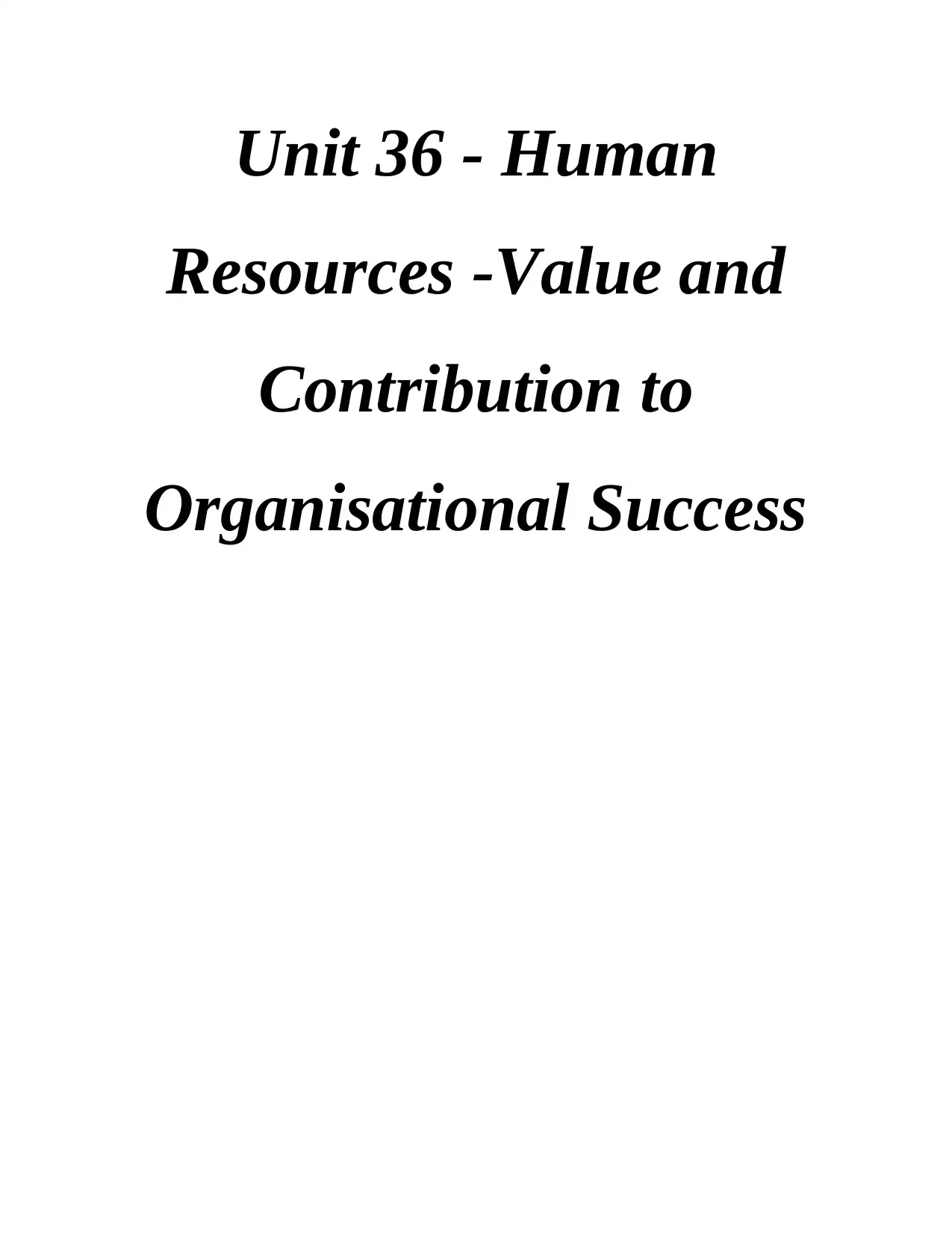
Unit 36 - Human
Resources -Value and
Contribution to
Organisational Success
Resources -Value and
Contribution to
Organisational Success
Paraphrase This Document
Need a fresh take? Get an instant paraphrase of this document with our AI Paraphraser

Table of Contents
INTRODUCTION...........................................................................................................................1
LO 1.................................................................................................................................................1
P1) Importance of organisational deign theory in context of organisational structure and
fulfilling organisational strategy.............................................................................................1
LO2..................................................................................................................................................5
P2) Different approaches and techniques used for attracting, maintaining, developing and
rewarding human resources to create a skilled and dedicated workforce..............................5
LO3..................................................................................................................................................7
Covered in PPT.......................................................................................................................7
LO4..................................................................................................................................................7
P4) Response of organisational design to respond and adapt to change management...........7
CONCLUSION................................................................................................................................8
REFERENCES................................................................................................................................9
INTRODUCTION...........................................................................................................................1
LO 1.................................................................................................................................................1
P1) Importance of organisational deign theory in context of organisational structure and
fulfilling organisational strategy.............................................................................................1
LO2..................................................................................................................................................5
P2) Different approaches and techniques used for attracting, maintaining, developing and
rewarding human resources to create a skilled and dedicated workforce..............................5
LO3..................................................................................................................................................7
Covered in PPT.......................................................................................................................7
LO4..................................................................................................................................................7
P4) Response of organisational design to respond and adapt to change management...........7
CONCLUSION................................................................................................................................8
REFERENCES................................................................................................................................9

⊘ This is a preview!⊘
Do you want full access?
Subscribe today to unlock all pages.

Trusted by 1+ million students worldwide

INTRODUCTION
Organisational design can be stated as the way in which an organization is used to be
structured as well as operated by its core members thus, organisational design is both a plan and
a process for a firm for fulfilling its organisational strategy (Arens, Fierz and Zúñiga, 2017). The
organisational which is used for current report is Syngenta which is a leading plant science
business of world that is emphasised towards promoting sustainable agriculture. This
organisation was formed in 2000 and currently having a workforce of 24000 employees
operating in more than 90 countries of world. This report consists of a discussion about
importance of organisational design in context of organisational structure along with approaches
and strategy to attract, maintain and develop skilled and dedicated workforce. At last, an analysis
about organisational design & change management is also there.
LO 1
P1) Importance of organisational deign theory in context of organisational structure and fulfilling
organisational strategy
Organizational design theory basically provides a theoretical underpinnings that could be
used by a firm for having an efficient and viable organizational design. Thus, Organization
design theory is mainly used ad adopted by a company to describe and how it works along with
design which builds and emphasis the world could possibly work (Biswas and Mazumder, 2017).
Thus, an analysis can be made that the organization theory is basically a positive science which
aim at explaining and understanding the structure along with behaviour, and effectiveness of an
organization. The organizational design is mainly a normative science that is used to
recommend effective organisational designs for having an increased level of effectiveness and
efficiency to fulfil the organisational strategy. The use of multi-contingency theory is most
suitable and appropriate for a firm to develop the relationships between structural, human, and
coordination components that is required by a company for representing as a series of
interconnected design rules for giving and leading most viable and efficient organisational design
in context of organisational structure and fulfilling organisational strategy.
Organizational design theory helps in underpinnings for organizational design which
effectively describes and explains how the world works which leads a complement in building
and leading out effective organization design and structure. Thus , an analysis can be made out
1
Organisational design can be stated as the way in which an organization is used to be
structured as well as operated by its core members thus, organisational design is both a plan and
a process for a firm for fulfilling its organisational strategy (Arens, Fierz and Zúñiga, 2017). The
organisational which is used for current report is Syngenta which is a leading plant science
business of world that is emphasised towards promoting sustainable agriculture. This
organisation was formed in 2000 and currently having a workforce of 24000 employees
operating in more than 90 countries of world. This report consists of a discussion about
importance of organisational design in context of organisational structure along with approaches
and strategy to attract, maintain and develop skilled and dedicated workforce. At last, an analysis
about organisational design & change management is also there.
LO 1
P1) Importance of organisational deign theory in context of organisational structure and fulfilling
organisational strategy
Organizational design theory basically provides a theoretical underpinnings that could be
used by a firm for having an efficient and viable organizational design. Thus, Organization
design theory is mainly used ad adopted by a company to describe and how it works along with
design which builds and emphasis the world could possibly work (Biswas and Mazumder, 2017).
Thus, an analysis can be made that the organization theory is basically a positive science which
aim at explaining and understanding the structure along with behaviour, and effectiveness of an
organization. The organizational design is mainly a normative science that is used to
recommend effective organisational designs for having an increased level of effectiveness and
efficiency to fulfil the organisational strategy. The use of multi-contingency theory is most
suitable and appropriate for a firm to develop the relationships between structural, human, and
coordination components that is required by a company for representing as a series of
interconnected design rules for giving and leading most viable and efficient organisational design
in context of organisational structure and fulfilling organisational strategy.
Organizational design theory helps in underpinnings for organizational design which
effectively describes and explains how the world works which leads a complement in building
and leading out effective organization design and structure. Thus , an analysis can be made out
1
Paraphrase This Document
Need a fresh take? Get an instant paraphrase of this document with our AI Paraphraser

that organisational theory of design is viable and most important to lead a better organisational
structure and fulfilling organisational strategy in a more viable and efficient way (Vestergaard
and Nørgaard, 2018). The main form of organisational structure that are supported and lead by
organisational design theory along with important in fulfilling the organisational strategy are
stated and analysed as follows:
Hierarchical structure- Under this form of organisational deign and structure a direct
chain of command is maintain by a firm from the top of the organization to the bottom. Further,
all the vital and critical decisions are made and taken by the senior management which are then
directed and passed down to the subsidiary levels of management.
Figure 1: Hierarchical structure, 2020.
Use of Hierarchical structure is commonly seen in large companies like Tesco and Aston
Martin which leads to creation of tall and wide organisational structure in which duties and role
of each level of management is clear defined (Safkaur and Sagrim, 2019). Thus, increase the
overall efficiency and performance of each level through clearer chains of command for better
organisational strategy and fulfilling its goals. Further, clearly defined career path and promotion
plan, enhanced level of department loyalty and control level along with clearly defined authority
are main befits of Hierarchical structure which encourages specialization for effectively fulfilling
2
structure and fulfilling organisational strategy in a more viable and efficient way (Vestergaard
and Nørgaard, 2018). The main form of organisational structure that are supported and lead by
organisational design theory along with important in fulfilling the organisational strategy are
stated and analysed as follows:
Hierarchical structure- Under this form of organisational deign and structure a direct
chain of command is maintain by a firm from the top of the organization to the bottom. Further,
all the vital and critical decisions are made and taken by the senior management which are then
directed and passed down to the subsidiary levels of management.
Figure 1: Hierarchical structure, 2020.
Use of Hierarchical structure is commonly seen in large companies like Tesco and Aston
Martin which leads to creation of tall and wide organisational structure in which duties and role
of each level of management is clear defined (Safkaur and Sagrim, 2019). Thus, increase the
overall efficiency and performance of each level through clearer chains of command for better
organisational strategy and fulfilling its goals. Further, clearly defined career path and promotion
plan, enhanced level of department loyalty and control level along with clearly defined authority
are main befits of Hierarchical structure which encourages specialization for effectively fulfilling
2

organisational strategy. The drawbacks of Hierarchical structure which is mainly faced by Tesco
plc comprises of slow action and decision making along with enhanced cost of operations.
Flat structure- It is an organisational structure which only have a few layers of
management where managers have a wide span of control with more subordinates. Thus, under
use of a flat organisational deign and structure usually facilitates a shorter chain of command to
have more effective mad fast decision making and action taking.
Figure 2: Flat structure, 2020
Use of flat organisational structure is mainly made by small orgnisation like ThirdWay
group plc which ensures a more effective communication through leading to less
miscommunication thus, plays a vital role in improving the morale of employees for better
performance and fulfilling organisational strategy (Li and Zhang, 2020). The drawback
associated with flat organisational structure seen in ThirdWay group plc comprises of limit in
productivity through hampering the expansion and growth of the company by maintaining a
simple flat structure which is not scalable.
Matrix structure- It is an organisational structure or design where an employee can
report to two or more number of manager rather than relying and depending on a single manager
as per the prevailing situation and complexity of project. Thus, use of Matrix structure supports
and facilitates a shared level of skill across all department allow a company to make effective
utilization of wide range of talents and viable strengths in a more effective and better manner.
3
plc comprises of slow action and decision making along with enhanced cost of operations.
Flat structure- It is an organisational structure which only have a few layers of
management where managers have a wide span of control with more subordinates. Thus, under
use of a flat organisational deign and structure usually facilitates a shorter chain of command to
have more effective mad fast decision making and action taking.
Figure 2: Flat structure, 2020
Use of flat organisational structure is mainly made by small orgnisation like ThirdWay
group plc which ensures a more effective communication through leading to less
miscommunication thus, plays a vital role in improving the morale of employees for better
performance and fulfilling organisational strategy (Li and Zhang, 2020). The drawback
associated with flat organisational structure seen in ThirdWay group plc comprises of limit in
productivity through hampering the expansion and growth of the company by maintaining a
simple flat structure which is not scalable.
Matrix structure- It is an organisational structure or design where an employee can
report to two or more number of manager rather than relying and depending on a single manager
as per the prevailing situation and complexity of project. Thus, use of Matrix structure supports
and facilitates a shared level of skill across all department allow a company to make effective
utilization of wide range of talents and viable strengths in a more effective and better manner.
3
⊘ This is a preview!⊘
Do you want full access?
Subscribe today to unlock all pages.

Trusted by 1+ million students worldwide
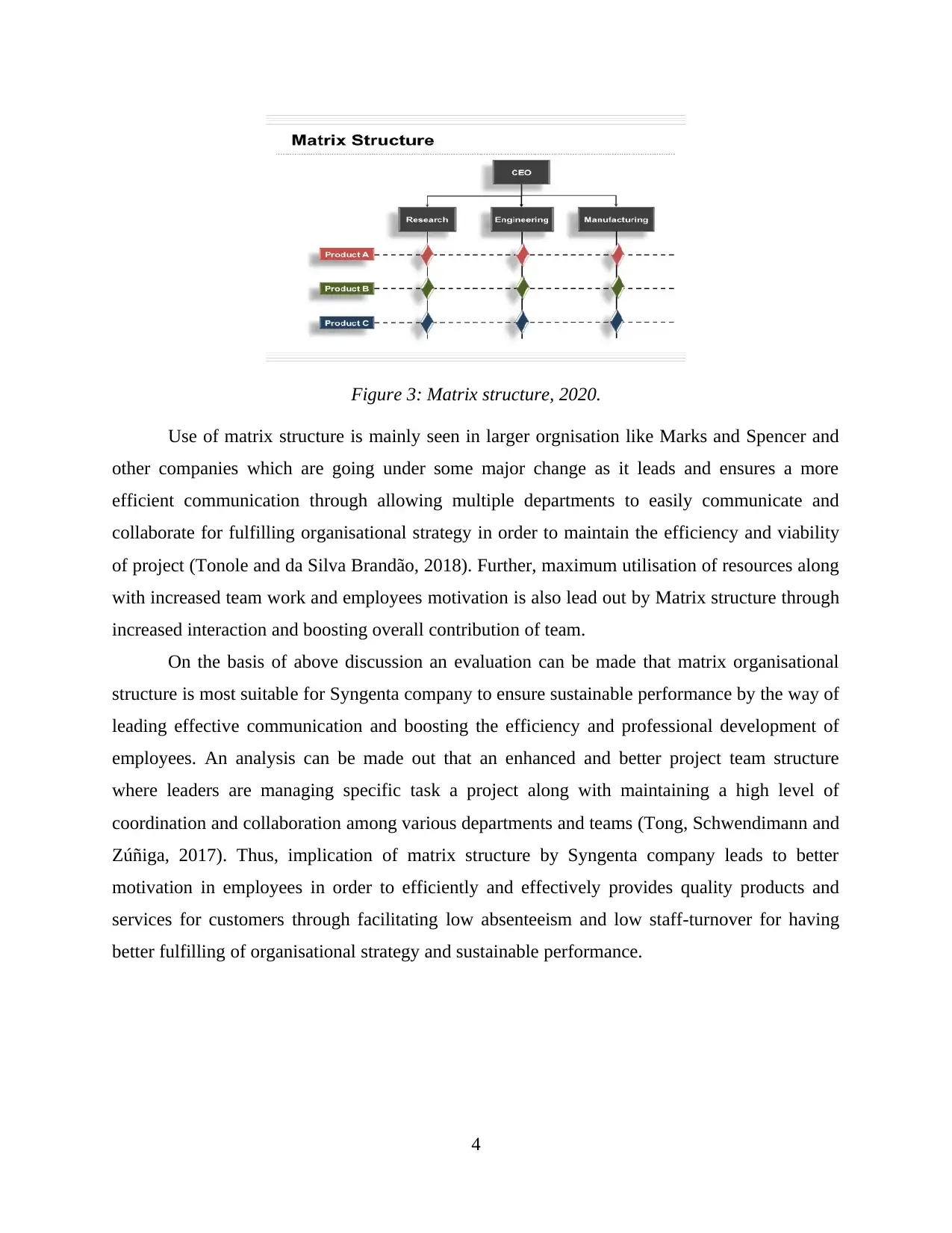
Figure 3: Matrix structure, 2020.
Use of matrix structure is mainly seen in larger orgnisation like Marks and Spencer and
other companies which are going under some major change as it leads and ensures a more
efficient communication through allowing multiple departments to easily communicate and
collaborate for fulfilling organisational strategy in order to maintain the efficiency and viability
of project (Tonole and da Silva Brandão, 2018). Further, maximum utilisation of resources along
with increased team work and employees motivation is also lead out by Matrix structure through
increased interaction and boosting overall contribution of team.
On the basis of above discussion an evaluation can be made that matrix organisational
structure is most suitable for Syngenta company to ensure sustainable performance by the way of
leading effective communication and boosting the efficiency and professional development of
employees. An analysis can be made out that an enhanced and better project team structure
where leaders are managing specific task a project along with maintaining a high level of
coordination and collaboration among various departments and teams (Tong, Schwendimann and
Zúñiga, 2017). Thus, implication of matrix structure by Syngenta company leads to better
motivation in employees in order to efficiently and effectively provides quality products and
services for customers through facilitating low absenteeism and low staff-turnover for having
better fulfilling of organisational strategy and sustainable performance.
4
Use of matrix structure is mainly seen in larger orgnisation like Marks and Spencer and
other companies which are going under some major change as it leads and ensures a more
efficient communication through allowing multiple departments to easily communicate and
collaborate for fulfilling organisational strategy in order to maintain the efficiency and viability
of project (Tonole and da Silva Brandão, 2018). Further, maximum utilisation of resources along
with increased team work and employees motivation is also lead out by Matrix structure through
increased interaction and boosting overall contribution of team.
On the basis of above discussion an evaluation can be made that matrix organisational
structure is most suitable for Syngenta company to ensure sustainable performance by the way of
leading effective communication and boosting the efficiency and professional development of
employees. An analysis can be made out that an enhanced and better project team structure
where leaders are managing specific task a project along with maintaining a high level of
coordination and collaboration among various departments and teams (Tong, Schwendimann and
Zúñiga, 2017). Thus, implication of matrix structure by Syngenta company leads to better
motivation in employees in order to efficiently and effectively provides quality products and
services for customers through facilitating low absenteeism and low staff-turnover for having
better fulfilling of organisational strategy and sustainable performance.
4
Paraphrase This Document
Need a fresh take? Get an instant paraphrase of this document with our AI Paraphraser

Human capital theory
Human resource theory tries to explain the wonders using a financial perspective. This
view shows evidence of superior human resources and sustainability in a complex business
world. The purpose of this writing study is to define, analyze and speak by identifying and
unifying the concept of human resources and aiming to help promote both human resources and
expert’s tables. A human resources hypothesis that is currently a human resources estimate has
also included many human resources and HR promotion proposals in terms of HR resilience, its
success and disappointment, and specific goals incorporating other ideas of human heritage
development.
In the world of the job market, individuals bring different levels of training, knowledge,
experience and skills just as they expect from the workplace. A more educated and better
equipped person is better equipped for a greater measure of positive results and benefits than one
with less education and preparation. The concept of human resources is generally considered as a
result of an increase in ranking, so the company relies on the knowledge of producers, on
information, on skill as an essential idea of value creation.
Human resources can be grouped into different types of leadership, preparation,
movement and well-being. Through such structures, manufacturers acquire knowledge, skills and
abilities in an unexpected way. Companies invest in human resources because they see people as
an asset and expect the return of what the company has to offer and offer a positive long-term
benefit. Therefore, an individual's interest in educating or preparing and expecting knowledge,
skills acquired will develop into professional success.
Syngenta can implement human capital theory to invest in its employees through training
and learning programmes. This will increase the efficiency of employees and also will improve
the productivity.
5
Human resource theory tries to explain the wonders using a financial perspective. This
view shows evidence of superior human resources and sustainability in a complex business
world. The purpose of this writing study is to define, analyze and speak by identifying and
unifying the concept of human resources and aiming to help promote both human resources and
expert’s tables. A human resources hypothesis that is currently a human resources estimate has
also included many human resources and HR promotion proposals in terms of HR resilience, its
success and disappointment, and specific goals incorporating other ideas of human heritage
development.
In the world of the job market, individuals bring different levels of training, knowledge,
experience and skills just as they expect from the workplace. A more educated and better
equipped person is better equipped for a greater measure of positive results and benefits than one
with less education and preparation. The concept of human resources is generally considered as a
result of an increase in ranking, so the company relies on the knowledge of producers, on
information, on skill as an essential idea of value creation.
Human resources can be grouped into different types of leadership, preparation,
movement and well-being. Through such structures, manufacturers acquire knowledge, skills and
abilities in an unexpected way. Companies invest in human resources because they see people as
an asset and expect the return of what the company has to offer and offer a positive long-term
benefit. Therefore, an individual's interest in educating or preparing and expecting knowledge,
skills acquired will develop into professional success.
Syngenta can implement human capital theory to invest in its employees through training
and learning programmes. This will increase the efficiency of employees and also will improve
the productivity.
5

LO2
P2) Different approaches and techniques used for attracting, maintaining, developing and
rewarding human resources to create a skilled and dedicated workforce.
Use of various approaches and techniques are made by companies for attracting,
maintaining, developing and rewarding human resources to create a skilled and dedicated
workforce. Among this making use of smart requirement process through effective advertising
along with facilitating effective motivation and higher job satisfaction among employees are vital
approaches and technique. In order to attract a larger number of talented and skilled candidate for
vacant job, use of effective job description strategy and approach is made by Syngenta company
along with ensuring effective advertising of this job description to reach all potential candidate in
order to attract larger number of talented candidate (Arens, Fierz and Zúñiga, 2017).
Apart from this, motivation and enhanced job satisfaction are vital for maintaining and
developing employers thus, use of suitable motivation theory along with use of viable leadership
style is made by Syngenta company to ensure a more skilled and dedicated workforce. The
motivation and leadership techniques and approach used by Syngenta company to attract,
maintain and develop its employees for creation of dedicated and skilled workforce are provided
as below:
Two Factor Theory
Use of Herzberg motivation theory is made by Syngenta company to ensure a high level
of motivation and satisfaction level of its employees. all the important factors that lead
significant impact on motivation level of employees are bifurcated in two main categories i.e.
Motivator and Hygiene factors to lead enhanced satisfaction level in employees in order to retain
and maintain them for longer period to create a dedicated ad skilled workforce. The motivator
factors consists of more challenging work along with leading regular recognition for one's
achievement and providing high responsibility and opportunity to do something meaningful
(TANDOĞAN, 2018). Further, proper involvement in decision making and sense of importance
to an organization is also provided by Syngenta company for its employees to develop higher
level of commitment and loyalty in employees which maintain skilled employees along with
creating a talented and dedicated workforce. Apart from this, the main hygiene factors that are
provided by Syngenta company for its employees consists of status, job security, timely salary
along with fringe benefits and positive working conditions that leads to reduction in job
6
P2) Different approaches and techniques used for attracting, maintaining, developing and
rewarding human resources to create a skilled and dedicated workforce.
Use of various approaches and techniques are made by companies for attracting,
maintaining, developing and rewarding human resources to create a skilled and dedicated
workforce. Among this making use of smart requirement process through effective advertising
along with facilitating effective motivation and higher job satisfaction among employees are vital
approaches and technique. In order to attract a larger number of talented and skilled candidate for
vacant job, use of effective job description strategy and approach is made by Syngenta company
along with ensuring effective advertising of this job description to reach all potential candidate in
order to attract larger number of talented candidate (Arens, Fierz and Zúñiga, 2017).
Apart from this, motivation and enhanced job satisfaction are vital for maintaining and
developing employers thus, use of suitable motivation theory along with use of viable leadership
style is made by Syngenta company to ensure a more skilled and dedicated workforce. The
motivation and leadership techniques and approach used by Syngenta company to attract,
maintain and develop its employees for creation of dedicated and skilled workforce are provided
as below:
Two Factor Theory
Use of Herzberg motivation theory is made by Syngenta company to ensure a high level
of motivation and satisfaction level of its employees. all the important factors that lead
significant impact on motivation level of employees are bifurcated in two main categories i.e.
Motivator and Hygiene factors to lead enhanced satisfaction level in employees in order to retain
and maintain them for longer period to create a dedicated ad skilled workforce. The motivator
factors consists of more challenging work along with leading regular recognition for one's
achievement and providing high responsibility and opportunity to do something meaningful
(TANDOĞAN, 2018). Further, proper involvement in decision making and sense of importance
to an organization is also provided by Syngenta company for its employees to develop higher
level of commitment and loyalty in employees which maintain skilled employees along with
creating a talented and dedicated workforce. Apart from this, the main hygiene factors that are
provided by Syngenta company for its employees consists of status, job security, timely salary
along with fringe benefits and positive working conditions that leads to reduction in job
6
⊘ This is a preview!⊘
Do you want full access?
Subscribe today to unlock all pages.

Trusted by 1+ million students worldwide
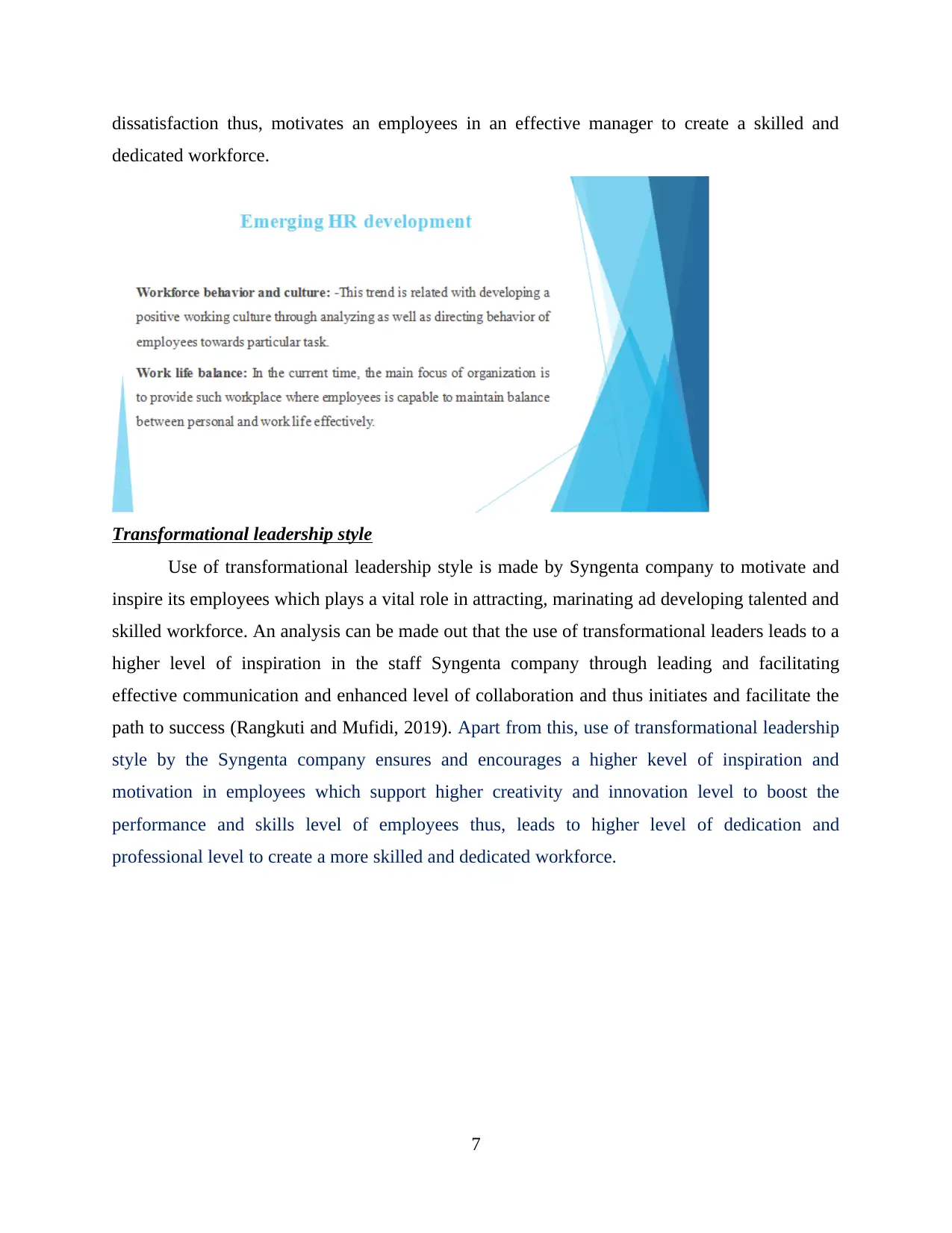
dissatisfaction thus, motivates an employees in an effective manager to create a skilled and
dedicated workforce.
Transformational leadership style
Use of transformational leadership style is made by Syngenta company to motivate and
inspire its employees which plays a vital role in attracting, marinating ad developing talented and
skilled workforce. An analysis can be made out that the use of transformational leaders leads to a
higher level of inspiration in the staff Syngenta company through leading and facilitating
effective communication and enhanced level of collaboration and thus initiates and facilitate the
path to success (Rangkuti and Mufidi, 2019). Apart from this, use of transformational leadership
style by the Syngenta company ensures and encourages a higher kevel of inspiration and
motivation in employees which support higher creativity and innovation level to boost the
performance and skills level of employees thus, leads to higher level of dedication and
professional level to create a more skilled and dedicated workforce.
7
dedicated workforce.
Transformational leadership style
Use of transformational leadership style is made by Syngenta company to motivate and
inspire its employees which plays a vital role in attracting, marinating ad developing talented and
skilled workforce. An analysis can be made out that the use of transformational leaders leads to a
higher level of inspiration in the staff Syngenta company through leading and facilitating
effective communication and enhanced level of collaboration and thus initiates and facilitate the
path to success (Rangkuti and Mufidi, 2019). Apart from this, use of transformational leadership
style by the Syngenta company ensures and encourages a higher kevel of inspiration and
motivation in employees which support higher creativity and innovation level to boost the
performance and skills level of employees thus, leads to higher level of dedication and
professional level to create a more skilled and dedicated workforce.
7
Paraphrase This Document
Need a fresh take? Get an instant paraphrase of this document with our AI Paraphraser
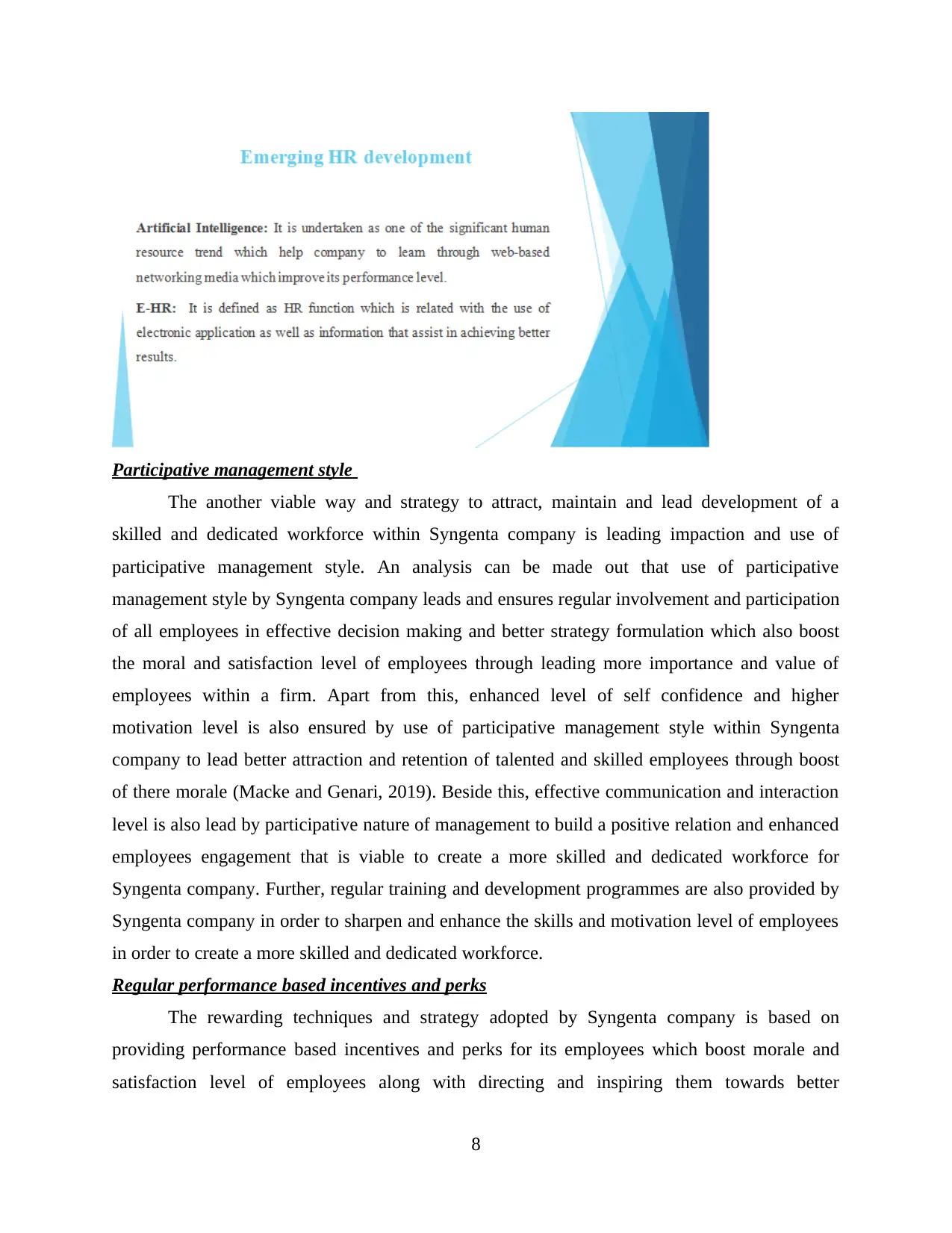
Participative management style
The another viable way and strategy to attract, maintain and lead development of a
skilled and dedicated workforce within Syngenta company is leading impaction and use of
participative management style. An analysis can be made out that use of participative
management style by Syngenta company leads and ensures regular involvement and participation
of all employees in effective decision making and better strategy formulation which also boost
the moral and satisfaction level of employees through leading more importance and value of
employees within a firm. Apart from this, enhanced level of self confidence and higher
motivation level is also ensured by use of participative management style within Syngenta
company to lead better attraction and retention of talented and skilled employees through boost
of there morale (Macke and Genari, 2019). Beside this, effective communication and interaction
level is also lead by participative nature of management to build a positive relation and enhanced
employees engagement that is viable to create a more skilled and dedicated workforce for
Syngenta company. Further, regular training and development programmes are also provided by
Syngenta company in order to sharpen and enhance the skills and motivation level of employees
in order to create a more skilled and dedicated workforce.
Regular performance based incentives and perks
The rewarding techniques and strategy adopted by Syngenta company is based on
providing performance based incentives and perks for its employees which boost morale and
satisfaction level of employees along with directing and inspiring them towards better
8
The another viable way and strategy to attract, maintain and lead development of a
skilled and dedicated workforce within Syngenta company is leading impaction and use of
participative management style. An analysis can be made out that use of participative
management style by Syngenta company leads and ensures regular involvement and participation
of all employees in effective decision making and better strategy formulation which also boost
the moral and satisfaction level of employees through leading more importance and value of
employees within a firm. Apart from this, enhanced level of self confidence and higher
motivation level is also ensured by use of participative management style within Syngenta
company to lead better attraction and retention of talented and skilled employees through boost
of there morale (Macke and Genari, 2019). Beside this, effective communication and interaction
level is also lead by participative nature of management to build a positive relation and enhanced
employees engagement that is viable to create a more skilled and dedicated workforce for
Syngenta company. Further, regular training and development programmes are also provided by
Syngenta company in order to sharpen and enhance the skills and motivation level of employees
in order to create a more skilled and dedicated workforce.
Regular performance based incentives and perks
The rewarding techniques and strategy adopted by Syngenta company is based on
providing performance based incentives and perks for its employees which boost morale and
satisfaction level of employees along with directing and inspiring them towards better
8
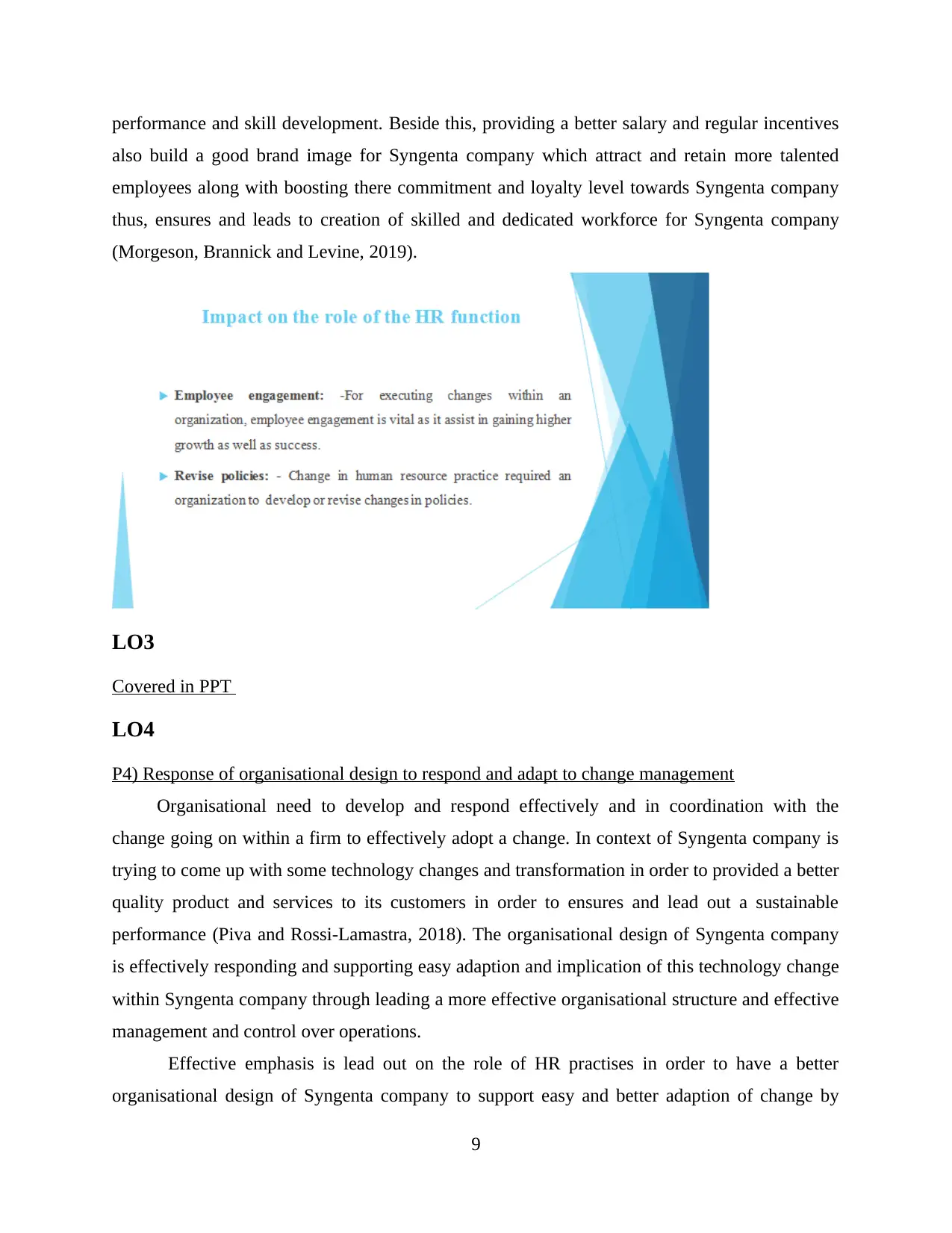
performance and skill development. Beside this, providing a better salary and regular incentives
also build a good brand image for Syngenta company which attract and retain more talented
employees along with boosting there commitment and loyalty level towards Syngenta company
thus, ensures and leads to creation of skilled and dedicated workforce for Syngenta company
(Morgeson, Brannick and Levine, 2019).
LO3
Covered in PPT
LO4
P4) Response of organisational design to respond and adapt to change management
Organisational need to develop and respond effectively and in coordination with the
change going on within a firm to effectively adopt a change. In context of Syngenta company is
trying to come up with some technology changes and transformation in order to provided a better
quality product and services to its customers in order to ensures and lead out a sustainable
performance (Piva and Rossi-Lamastra, 2018). The organisational design of Syngenta company
is effectively responding and supporting easy adaption and implication of this technology change
within Syngenta company through leading a more effective organisational structure and effective
management and control over operations.
Effective emphasis is lead out on the role of HR practises in order to have a better
organisational design of Syngenta company to support easy and better adaption of change by
9
also build a good brand image for Syngenta company which attract and retain more talented
employees along with boosting there commitment and loyalty level towards Syngenta company
thus, ensures and leads to creation of skilled and dedicated workforce for Syngenta company
(Morgeson, Brannick and Levine, 2019).
LO3
Covered in PPT
LO4
P4) Response of organisational design to respond and adapt to change management
Organisational need to develop and respond effectively and in coordination with the
change going on within a firm to effectively adopt a change. In context of Syngenta company is
trying to come up with some technology changes and transformation in order to provided a better
quality product and services to its customers in order to ensures and lead out a sustainable
performance (Piva and Rossi-Lamastra, 2018). The organisational design of Syngenta company
is effectively responding and supporting easy adaption and implication of this technology change
within Syngenta company through leading a more effective organisational structure and effective
management and control over operations.
Effective emphasis is lead out on the role of HR practises in order to have a better
organisational design of Syngenta company to support easy and better adaption of change by
9
⊘ This is a preview!⊘
Do you want full access?
Subscribe today to unlock all pages.

Trusted by 1+ million students worldwide
1 out of 17
Related Documents
Your All-in-One AI-Powered Toolkit for Academic Success.
+13062052269
info@desklib.com
Available 24*7 on WhatsApp / Email
![[object Object]](/_next/static/media/star-bottom.7253800d.svg)
Unlock your academic potential
Copyright © 2020–2025 A2Z Services. All Rights Reserved. Developed and managed by ZUCOL.



